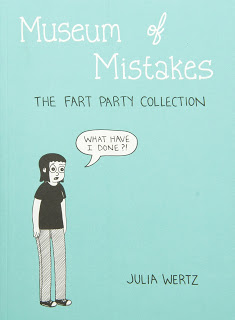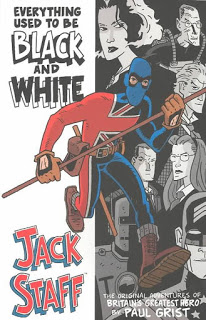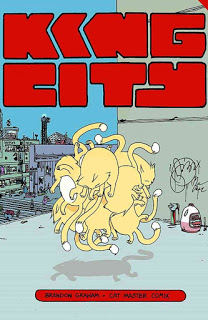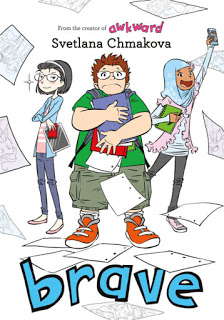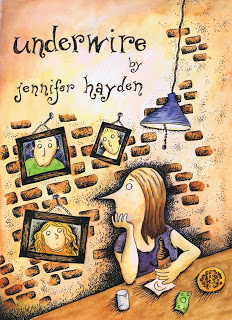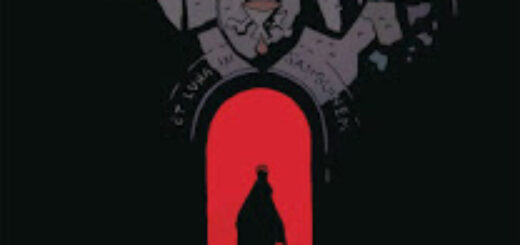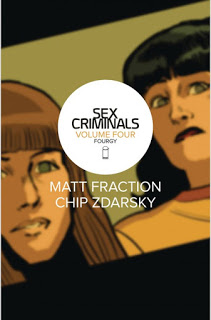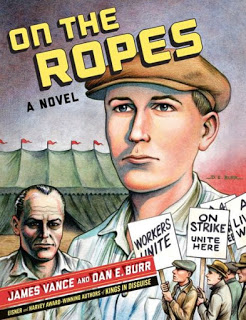Book-A-Day 2018 #48: Shoulder-A-Coffin Kuro, Vols. 4 & 5 by Satoko Kiyuduki
Reading a book at four-year intervals is probably not the best way to keep it in the front of one’s mind. But I read the first two volumes of Shoulder-A-Coffin Kuro (one and two) back in 2010, and then the third in 2014, so, since it’s 2018 now, I couldn’t continue any earlier than now, can I?
(It would be nice to have a time machine, but, in real life, “today” is always the earliest anything can be done.)
 So here I am in 2018, having just read Volumes Four
and Five
of Shoulder-A-Coffin Kuro, a comic I remember enjoying quite a bit back then. But, this time, I’m not as enthusiastic about Satoko Kiyuduki’s world and storyline — much of the dialogue feels like a lot of pseudo-philosophical windiness that doesn’t actually say anything (that could be translation issues, though, or lack of cultural context on my part) and the vertical 4-koma format (except for some pages that read right-to-left like regular manga, to trip me up) forces every interaction and conversation into the same four-box structure with a punch-line-like zinger at the end.
So here I am in 2018, having just read Volumes Four
and Five
of Shoulder-A-Coffin Kuro, a comic I remember enjoying quite a bit back then. But, this time, I’m not as enthusiastic about Satoko Kiyuduki’s world and storyline — much of the dialogue feels like a lot of pseudo-philosophical windiness that doesn’t actually say anything (that could be translation issues, though, or lack of cultural context on my part) and the vertical 4-koma format (except for some pages that read right-to-left like regular manga, to trip me up) forces every interaction and conversation into the same four-box structure with a punch-line-like zinger at the end.
Kuro is a young woman, but precisely how young is difficult to say. She’s drawn to look pre-teen, but that could just be a style. She was cursed by a witch, for reasons and in a way that still isn’t entirely clear at this point, and has to wander the world, lugging her coffin, until she either becomes a witch herself or dies. (As finally becomes semi-explicit in these volumes.) This is not nearly as dramatic as you’re hoping it will be. Instead, she does a lot of vague talking about what it means to be a traveler, except when other characters are saying similar, and if possible even vaguer, things.
We also get an origin for that witch — I think; it’s someone’s origin and it’s not Kuro’s — somewhere in the middle here. It’s sad but vaguely pointless, unless meant to underline that life is arbitrary and capricious and that everything kinda sucks. The witch is also traveling, though she doesn’t have strong opinions on the subject the way other characters do. And they’re traveling through vaguely fantasy-ish lands, nowhere in particular and far away from cities and large groups of people and anything particularly exciting.
Kuro does occasionally wander through pieces of other stories along her travels, but she’s always at the center: everyone is happy to stop whatever they’re doing to engage in long conversations with the little girl lugging her own coffin. Late in the second volume, someone actually tries to kill Kuro, which at least adds a bit of variety. It doesn’t take, of course.
Kuro is not as mopey as she could be: she’s more dogged, in that essential manga way, devoted to keeping on moving forward and being as positive as she can be until something new happens. That’s encouraging, but I still wanted things to happen here, and not just have a moment of “oh, gosh, we all perceive this area differently! isn’t that odd” before Kuro and her companions move on.
So: the 4-koma format is inherently episodic and distancing, and is tending to make Shoulder-a-Coffin Kuro spin its wheels through the same few philosophical thoughts at this point in its life. And sometimes mysteries are much more enticing than their solutions: I think this is a fine example of that effect. The fact that this book is published at really long intervals — a sixth volume, I see, just came out last fall — doesn’t help much, either.
![]()
![]()
Reposted from The Antick Musings of G.B.H. Hornswoggler, Gent.
















